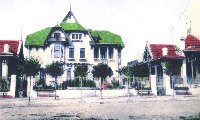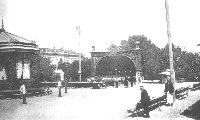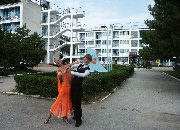|
|
|
Evpatoria’s history covers 2500 years. The city is one of the ten oldest cities of the former Soviet Union. It is younger than Yerevan and Kerch, but older than Feodosia, Tashkent, Moscow or Kiev. For the 2.5 millennia of its existence, the city has had three names. Evpatoria, in the words of a guide, is a "city with an incredibly rich historical past." The traces of time, whimsically intertwining, create unique sensations for the visitor. In two to three hours of walking you can visit three cities: ancient Kirkinitida, medieval Gozlov and modern Evpatoria. It all began with the ancient city of Kirkinitida, when Greek settlers ceremonially lit the sacred fire of Hestia, the goddess of the hearth.
In the 70s and 60s of the fifth century BC, the settlement’s territory was encircled with strong fortifications and the city itself was divided into clear quarters of stone houses. The city minted its own coin, illustrating its economic development and political stability. In the fourth century BC, Kirkinitida was incorporated into the State of Hersonesses.
In 40s of the second century BC, the city and its harbor were overtaken by the Scythians. Its fortifications and buildings were completely destroyed. In 83 BC Hersonessites won back their coast. Then the military commander Diophant laid the foundations for a fortress named Evpatorion, in honor of the reigning Pontic Tsar Mitridata VI Evpatora - the first mention of the town’s modern name.
In the following few centuries Greeks, Scythians and other peoples (Khazars, Pechenegs, Polovets) inhabited the coast, from time to time replacing each other.
In the tenth and eleventh centuries AD, immigrants from the Kievian Rus appeared on Crimea’s west coast.
In the thirteenth century AD, the Tatar-Mongol invasion tore through Crimea. Researchers maintain that the Tatar-Mongol conquerors were never fully ensconced at the coast.
After the Ottoman empire’s seizure of the entire Crimean coast in 1475, sultan Mehmed II al Fatih, The Conqueror (1432-1481), founded the Gozlov fortress on the territory of former Kirkinitida. The city was densely built up. The narrow curves of the alleys divided the city into quarters: Moslem, Armenian, Greek, Karaites and Gipsy. Gozlov was famous for its mosques, beautiful fountains, good sewer systems and Turkish baths. In the sixteenth century Khan Gazi-Girey II moved his residence and mint here and although development had not had much time, the city gained importance as the second and sea capital of the Crimean Khanate. The first mention of the city as Gozlov was in 1478. By agreement with the Ottomans, the Crimean Khanate recognized its dependency on Turkey. Accordingly Sultan Mehmed II had the right to maintain a garrison in Gozlov. Nominally it had been listed as part of the Crimean Khanate, Gozlov, after the conquest of Byzantium and the destruction of the Byzantine Empire, fell under the power of the sultan and became a vassal territory. Only in some cases could the khans require tribute from Evpatoria. The sultan’s trusted pashas oversaw Evpatoria.
During the Russo-Turkish War, Gozlov was twice taken by Russian troops: In 1736 by General-Field Marshal Minihom and in 1771 by an army of General Dolgorukova. In October 1778, the great Russian military leader Suvorov founded his staff-apartment in Gozlov (transferred from Bachesarai). At that time, the future generalissimo of the Russian armies was ‘merely’ a general-lieutenant and commanded the Russian troops in Crimea and Kyban.
On April 8 1783 Crimea became part of the Russian empire. The modern name Evpatoria was conferred in 1784 under the Russian empress Katherine II (1729-1796). During Katherine’s rule, by a declaration of February 8 1784, the Tavrichesky region and its division into 7 districts, including the Evpatorian district, was created. On April 24, 1784, Evpatoria was appointed a district city of the Tavrichesky region. In 1786, the Evpatoria port was released from payment of customs duties for five years. For long time the city was referred to as Kozlovim and on March 28, 1826, there was ruling that Evpatoria was not to be referred to as Kozlov, but henceforward only as Evpatoria.
The Crimean War of 1854-1856 interrupted the city’s development and inflicted significant damage upon it.
 After the war’s conclusion, Evpatoria continued as a small Crimean port where vacationers from other Crimean cities came to visitor. But in the 1880s, the picture changes. It was at this time, in 1886, at the Moynaki salt lake, that physician Hodzhawh and Tsetzenevskiy built a health clinic, giving a strong push for the development of Evpatoria as a resort. Along the coast from Cape Karantin (the sea port area) to the Lake Moynaki lake spillway, mansions, dachas, pensions and hotels sprouted up like mushrooms after rain. Evpatoria has the best swimming and mud therapy in Crimea.
In 1891 a hydro-meteorological station was built in Evpatoria. "...here observations on precipitation, air and sea temperature, clouds, wind direction and power, sea conditions and barometric and other observations are made."
"At the end of Evpatoria’s Cape Karantin, at a height of 30 feet above sea level and installed in 1897, is a lighthouse with a small alternating white and green light (kerosene) illuminating part of the horizon..., visible to ships for many miles".
The city grew outwards. New regions were constructed. Not far from the embankment, the hotels Beylera, Borivaz, Modern, Dyulber and others were established. Public buildings with interesting architecture were erected: the town theatre, a public library. A city tram began working on May 10, 1914 and in 1915 the branch line Sarabus (now Ostraykova Station)- Evpatoria connected the city with the country’s railway network.
After the war’s conclusion, Evpatoria continued as a small Crimean port where vacationers from other Crimean cities came to visitor. But in the 1880s, the picture changes. It was at this time, in 1886, at the Moynaki salt lake, that physician Hodzhawh and Tsetzenevskiy built a health clinic, giving a strong push for the development of Evpatoria as a resort. Along the coast from Cape Karantin (the sea port area) to the Lake Moynaki lake spillway, mansions, dachas, pensions and hotels sprouted up like mushrooms after rain. Evpatoria has the best swimming and mud therapy in Crimea.
In 1891 a hydro-meteorological station was built in Evpatoria. "...here observations on precipitation, air and sea temperature, clouds, wind direction and power, sea conditions and barometric and other observations are made."
"At the end of Evpatoria’s Cape Karantin, at a height of 30 feet above sea level and installed in 1897, is a lighthouse with a small alternating white and green light (kerosene) illuminating part of the horizon..., visible to ships for many miles".
The city grew outwards. New regions were constructed. Not far from the embankment, the hotels Beylera, Borivaz, Modern, Dyulber and others were established. Public buildings with interesting architecture were erected: the town theatre, a public library. A city tram began working on May 10, 1914 and in 1915 the branch line Sarabus (now Ostraykova Station)- Evpatoria connected the city with the country’s railway network.
 In less than 20 years, from 1900 to 1917, the look of the city changed. Its area increased nearly two times, the streets of the Dacha region had regular planning and the streets of the central area were paved and parks and gardens appeared. The small town of Evpatoria became a fashionable Russian resort.
As 1917 approached the world was calm and resort of Evpatoria lived in the past. Ahead was Revolution and Civil War - one of the bloodiest periods in the history of Evpatoria and Crimea.
The years of 1917 to 1920 were dramatic, not just for mighty Russia, but also for little Evpatoria. In these years power over the city changed repeatedly. This led to the decay of the town facilities and resort. On November 14, 1920, Latvian artillery divisions entered the city and Soviet power definitively reigned over Evpatoria.
During the years of the Great Patriotic War, Evpatoria’s inhabitants managed to survive the terrible 29-month occupation of the city by the fascists and felt a brief moment of freedom the day of the Evpatorian sea landing on January 1942. More than twelve thousand townsfolk executed at Krasnoi Gorke (red hill) as well as 2500 people lost on the World War II front were mourned.
On April 13 1944, part of the 2nd Army Guard entered the city and the citizens knew the joy of final liberation from fascist captivity. The German-fascist invaders caused the city and resort damage in the amount of 334,951,066 Rubles. At that time this was an enormous amount of money. Of 36 sanatorium-resort institutions only 6 survived and they required major repair. The beautiful beaches were disfigured with trenches and craters.
Reconstructing the resort was a feat of labor by the Evpatorians. By the summer season of 1948, the resort was restored to its pre-war level.
In less than 20 years, from 1900 to 1917, the look of the city changed. Its area increased nearly two times, the streets of the Dacha region had regular planning and the streets of the central area were paved and parks and gardens appeared. The small town of Evpatoria became a fashionable Russian resort.
As 1917 approached the world was calm and resort of Evpatoria lived in the past. Ahead was Revolution and Civil War - one of the bloodiest periods in the history of Evpatoria and Crimea.
The years of 1917 to 1920 were dramatic, not just for mighty Russia, but also for little Evpatoria. In these years power over the city changed repeatedly. This led to the decay of the town facilities and resort. On November 14, 1920, Latvian artillery divisions entered the city and Soviet power definitively reigned over Evpatoria.
During the years of the Great Patriotic War, Evpatoria’s inhabitants managed to survive the terrible 29-month occupation of the city by the fascists and felt a brief moment of freedom the day of the Evpatorian sea landing on January 1942. More than twelve thousand townsfolk executed at Krasnoi Gorke (red hill) as well as 2500 people lost on the World War II front were mourned.
On April 13 1944, part of the 2nd Army Guard entered the city and the citizens knew the joy of final liberation from fascist captivity. The German-fascist invaders caused the city and resort damage in the amount of 334,951,066 Rubles. At that time this was an enormous amount of money. Of 36 sanatorium-resort institutions only 6 survived and they required major repair. The beautiful beaches were disfigured with trenches and craters.
Reconstructing the resort was a feat of labor by the Evpatorians. By the summer season of 1948, the resort was restored to its pre-war level.
 In the following decades, Evpatoria’s development was very intensive. At the end of the 60s and 70s new sanatoriums and pioneer camps were built literally each holiday season. Together with the resort’s growth, the city’s infrastructure developed and modernized and the whole city improved. For instance, just in 1969 new several sanatoriums were constructed as well as a pioneer camps, seven shops and cafes, 14 businesses and secondary school #8.
Today Evpatoria covers 6539 Hectares with a population of more than 120,000 people. The villages of Zaozernoye, Mirny and Novo-ozerny operate under the city’s infrastructure.
Evpatoria’s 2500-year history is a prominent event in man’s history, enough that it is worthy to consider the specific fate of this city, preserving and developing itself, at a time when the fates decreed that whole peoples and states were to be swept off the face of the land...
In the following decades, Evpatoria’s development was very intensive. At the end of the 60s and 70s new sanatoriums and pioneer camps were built literally each holiday season. Together with the resort’s growth, the city’s infrastructure developed and modernized and the whole city improved. For instance, just in 1969 new several sanatoriums were constructed as well as a pioneer camps, seven shops and cafes, 14 businesses and secondary school #8.
Today Evpatoria covers 6539 Hectares with a population of more than 120,000 people. The villages of Zaozernoye, Mirny and Novo-ozerny operate under the city’s infrastructure.
Evpatoria’s 2500-year history is a prominent event in man’s history, enough that it is worthy to consider the specific fate of this city, preserving and developing itself, at a time when the fates decreed that whole peoples and states were to be swept off the face of the land... | |

